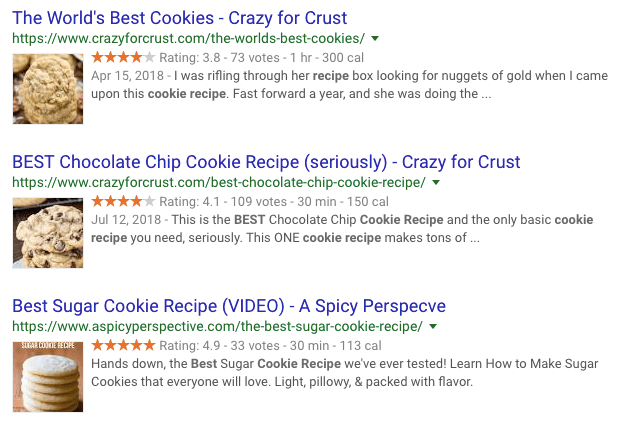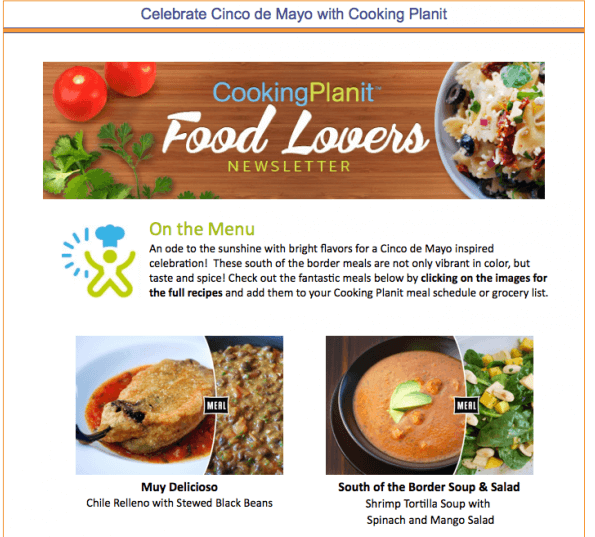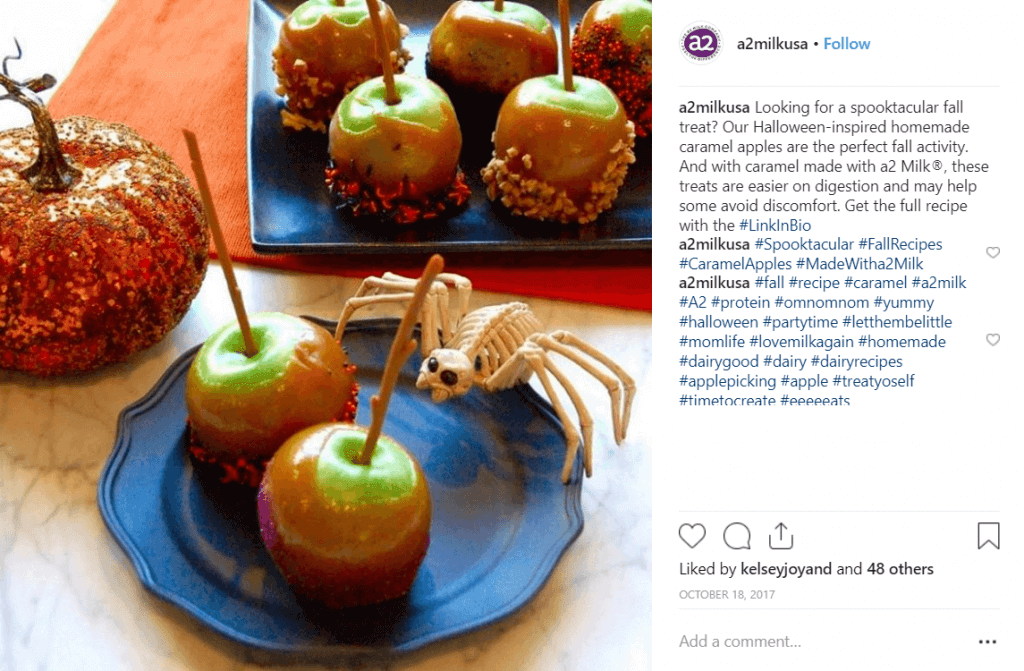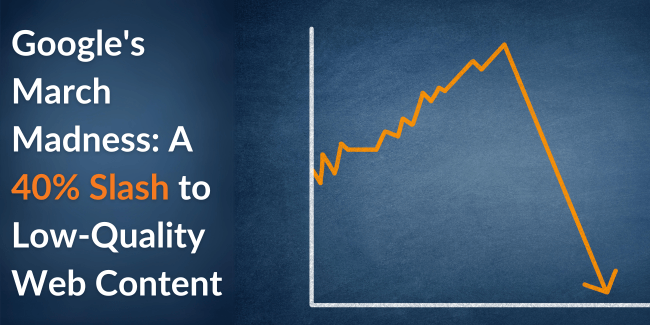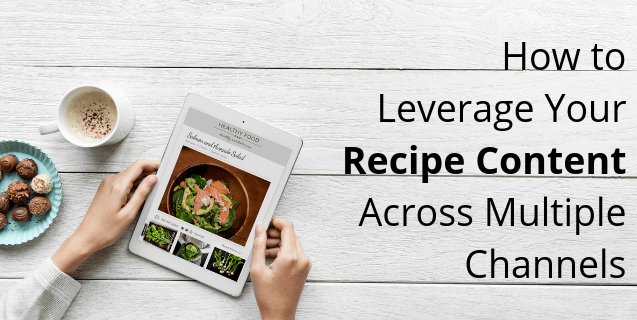
How to Leverage Recipe Content Across Multiple Channels
With a food-based brand, one of the easiest and most accessible types of content to create is recipes. Recipes can highlight your brand and make it easy for your audience to visualize using your products (which is the whole point of marketing in general).
But many food brands neglect to promote recipes across multiple channels or even multiple mediums; it’s usually relegated to their blog and possibly a couple social media posts. And while recipes do serve as evergreen content, it’s important to give this content more reach — and therefore more audience — by promoting it in multiple places.
Using different channels, including your own website, social media, and affiliate marketing, can go a long way in leveraging your recipe content to get more ROI out of it and to reach more people with your products.
Adding recipe content to your website
The first and most important place a recipe should go is on your website. Whether that means on your recipe page or in a blog post, your website is where the content should be housed for maximum impact.
To get the most out of your website’s new recipe, you should:
- Use more than one image. Unfortunately, many sites don’t focus on this element of their content creation for the sake of “just getting something up.” When it comes to recipes that will potentially sell product, however, you need great images. Take the time.
- Use more than one image. A common theme throughout most recipe content is only having one high-quality image displaying the final product. While this does make production faster, it can limit how well your audience responds (and how much reach your content has). In addition to the featured or final product image, consider documenting:
- The ingredients or utensils
- The preparation of the ingredients or workspace
- Each step in the recipe
- The final product
Don’t be afraid to get creative with your images, as this will help your recipe stand out in a sea of similar content.
- Use proper keywords in the content. Even if you’re going for a boost to your brand name, it’s important to include keywords that will connect with a wider audience. For example, don’t just use “Feel Good Foods Recipe” if your brand name is Feel Good Foods. Instead, use “Feel Good Foods Favorite Cookie Recipe.” You get your brand name in there, but you also get the keyword phrase ‘favorite cookie recipe,’ which will connect with a wider search. Use your keywords in your:
-
- Page title (meta title)
- Meta description
- The H1 and H2s
- Copy, although sparingly
- Optimize each image for search. Because of Google’s new rich results for recipes, it’s important to optimize your images and your entire recipe page. This includes:
- Adding keyword-rich alt text to each image
- Using open graph code for Facebook and other platforms
- Creating an attractive featured image
- Using schema markup to pull rich snippet content for:
- Images
- Recipe ratings
- Cook time
- Calories
The image below shows how schema markup can influence your search engine result and how this makes it easier for users to find the most relevant or highest-rated recipe for their needs.
While schema markup can be semi-complex, especially for small brands attempting to optimize their websites themselves, it’s an important resource that can help your recipe content rank higher and therefore get more traffic. Take the time to learn schema markup strategies or outsource this to someone you trust.
Where to share your recipe content
Now that you’ve optimized your recipe content on your website, it’s time to start sharing it on other platforms to gain maximum reach and traffic. After all, most people don’t refresh your recipe or blog page, hoping to see something new pop up — they are usually notified somehow.
Below are a few places you can share recipe content to ensure people actually see it.
Your email newsletter
A great way to “notify” readers and customers of a new recipe is to add the recipe to your email newsletter or create a special email list opt-in for people who want to know when a new recipe is posted. This could be a weekly email, a recap email once a month, or RSS-feed style emails where subscribers get a notification each time a new recipe blog is published.
According to GetResponse, restaurant and food email lists have a more than 35% open rate — one of the highest rates in email marketing (with the average being about 20%). This is good news for you, especially if you have people sign up specifically for notifications about new recipes.
YouTube or Facebook videos
Most brands don’t consider the different mediums that recipe content can take; often, it’s a long-form blog with a few pictures. But your recipe content can be so much more. Enter: recipe videos.
YouTube has one of the largest markets for “food channels,” which are largely composed of brands sharing their recipe video content. In fact, YouTube reports over 280% growth in food channel subscriptions each year. On Facebook, there is an average of 11,000 interactions (views, likes, shares, etc.) for food content videos. That’s a lot of potential just waiting to be tapped.
Don’t worry, though. Your brand doesn’t have to create a full-length cooking show for your audience; statistics show that videos around 60 to 90 seconds are best for audience engagement on most platforms. This is a great way to introduce the ingredients and the final delicious result — without giving it all away. Instead, you can include just enough information (and taste tease) to encourage viewers to click the link to get the full recipe.
DiaResQ’s short Facebook video is a great example of what you can do to highlight your recipe and products in just a short timeframe:
Another statistic worth noting: Facebook users spend 300% more time watching live videos than pre-recorded ones. Consider streaming your recipe creation live and saving the recording into your video archives. You can also embed the video within your blog post later.
Remember those images you created for your recipe? They’re going to help you with more than just your blog aesthetics or Google search results — they’re also perfect for Pinterest. Pinterest is a powerhouse for recipe content, as the platform’s image thumbnails allow for longer and more attractive images to be shared, or “pinned,” for future use. Pinterest also serves as a virtual cookbook for many people who “pin” recipes for different meals, occasions, and even diets.
For each recipe you create, also make a series of different pins that:
- Use multiple dominant colors. Reds, oranges, and browns perform better than blues.
- Show mostly the products and food. Avoid human faces if possible.
- Provide close-ups. Avoid too much background in your pictures. Buffer finds that repins decrease 4x if an image is more than 40% background.
- Use light and proper focus. Images that are oversaturated or too dark don’t attract the same number of pins.
- Include a text overlay. Add text to your image, with a title or call to action that attracts people to click. An enticing recipe title or claim like “The Best Cookie Recipe We’ve Found” can get people to pin your recipe and/or click through.
Of course, make sure to hyperlink each Pinterest image to your recipe’s location on your website and use keywords in the Pin description. Pinterest’s native search function is a great way to find Pinterest-specific keywords to include.
Beautiful pictures a big hit on Instagram, so those perfectly posed and clean images you created for your recipe content will serve you well on this platform. To get people interested in your recipe, create captions that are enticing as well as optimized with relevant hashtags, both branded and generic.
The a2 Milk image above is a great example of how to use hashtags for your recipe content. Social Media Examiner recommends using:
- 5-7 extremely popular hashtags (100,000 to 500,000 posts)
- 5-7 moderately popular hashtags (10,000 to 100,000 posts)
- 3-5 niche-specific hashtags
- 1-3 branded hashtags
The one downside to using Instagram for conversion traffic is that there is not usually a way to hyperlink your images to your content. If you do not have 10,000+ followers, you can update the link in your bio to include that day’s or week’s recipe and then you can include “Link in bio” in your photo’s caption.
If you have more than 10,000 followers, however, you can share your recipe content within your Instagram Stories with a “Swipe Up” call to action that links directly to the content. You can also create “Shoppable posts” on Instagram, if you’re hoping to sell a particular product associated with your recipe.
Instagram, while lacking in direct hyperlink-ability, is home to a number of “influencers” and potential affiliates that you can use to really expand your recipe (and brand) reach.
Affiliate marketing for recipe content
While you have your recipe content housed on your website and shared on your social media, it is incredibly beneficial to find affiliates or partners to share your content. Affiliates can take a number of forms, including:
- Popular blogs where you purchase a sponsored post
- Influencers who share or review your recipe for a nominal fee
- A mutually beneficial agreement (a percent of sales, a feature “swap,” etc.)
Affiliate marketing can be as simple as pitching your recipe to a recipe compilation blog, asking for a feature or recipe share from a customer with a large following, or working with an Instagram influencer to create a special hashtag their audience can use when making your recipe.
Getting your recipes published on other, higher traffic websites is also a great way to lend trust and gain interest from new audiences. It will also build third-party trust, which signals to Google that your site is worthy of a higher ranking.
A final note on recipe content
As a food brand, the end goal is always to sell more of your product. While paid ads for your individual products can go a long way in that regard, creating recipe content is one of the best ways to show people how to use your products. By getting your recipes in front of as many people as possible, you’re showing them how easy it is to make delicious food in their own homes using your brand.
That sort of personal touch makes “the final sell” that much easier.
Recipe content is also a great way to engage your current and potential customers, allowing them to share their own twists on your recipes or rave about the delicious final product. In the end, you want a network of people sharing your recipe and enjoying your food. If you keep that in mind, it can be much easier to optimize recipe content and get it in front of the right audience.





